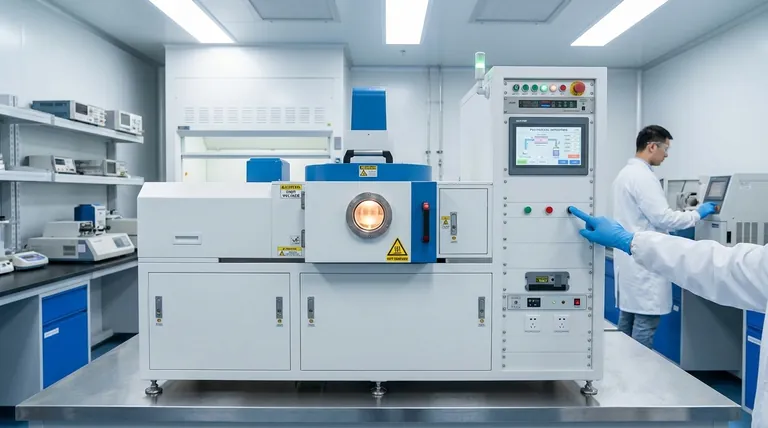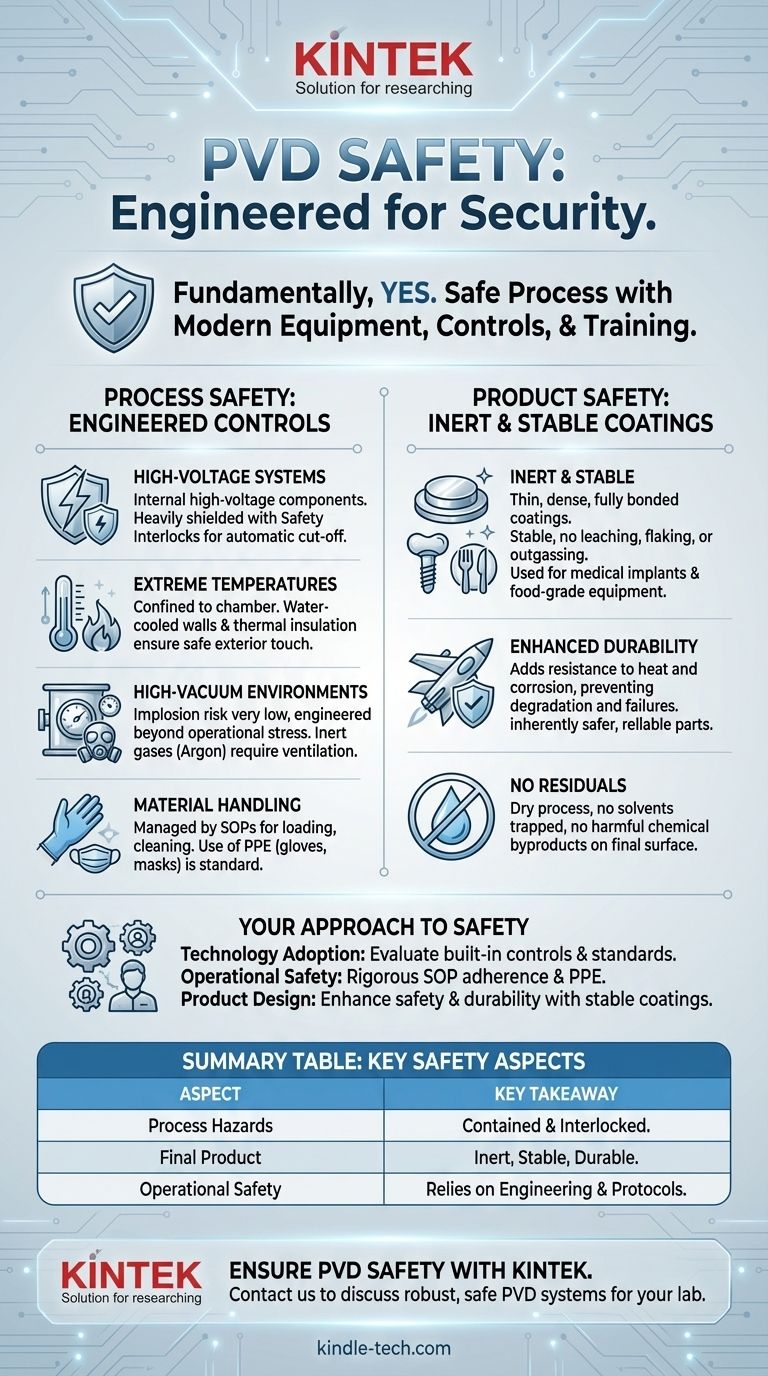Fundamentally, yes, physical vapor deposition (PVD) is a safe process when conducted using modern equipment with proper engineering controls and operator training. The process itself involves high-energy physics within a sealed vacuum, but the hazards are well-understood and effectively contained. The safety of PVD is not a matter of chance but a deliberate result of robust system design and strict operational protocols.
The safety of PVD is not inherent to the physics but is engineered into the system. The process involves significant hazards like high voltages and extreme temperatures, but these are contained within a sealed vacuum chamber, making modern PVD systems exceptionally safe for trained operators.

Deconstructing the Hazards of the PVD Process
To understand PVD safety, we must first identify the potential hazards involved in the process itself. These are almost entirely isolated from the operator by the equipment's design.
High-Voltage Electrical Systems
PVD methods like sputtering and e-beam evaporation rely on high-voltage power to generate plasma or energize an electron beam. This presents a significant electrical hazard.
However, all high-voltage components are internal to the machine and heavily shielded. Safety interlocks are a standard, critical feature that automatically cuts power if access panels are opened, preventing any operator exposure.
Extreme Temperatures and Thermal Risks
The thermal evaporation technique involves heating source materials to temperatures high enough to cause vaporization. This creates an intense thermal environment inside the chamber.
These extreme temperatures are confined to the vacuum chamber. The chamber walls are often water-cooled, and the system is thermally insulated, ensuring the exterior of the equipment remains safe to the touch during operation.
High-Vacuum Environments
PVD processes are conducted in a high-vacuum environment. This poses a very low but non-zero physical risk of chamber implosion if the structural integrity is compromised.
Modern vacuum chambers are engineered to standards far exceeding their operational stress, making such an event exceptionally rare. A more practical consideration is the use of inert gases like argon for sputtering, which could pose an asphyxiation risk if a major leak occurred in a poorly ventilated room.
Material Handling
The source materials used for deposition and the cleaning of the chamber post-process are the primary points of potential exposure. Some materials may be hazardous in powdered form.
This risk is managed through Standard Operating Procedures (SOPs) for material handling, which include the use of personal protective equipment (PPE) like gloves and masks when loading materials or performing system maintenance.
Is the Final PVD-Coated Product Safe?
Once the PVD process is complete, the resulting product is not only safe but often enhances the safety and longevity of the original part.
Inert and Stable Coatings
PVD applies an extremely thin, dense, and solid layer of material, such as a metal or ceramic. These coatings are fully bonded to the substrate and are highly stable and inert.
Because the coating is physically bonded and chemically stable, it does not leach, flake, or outgas. This is why PVD coatings are frequently used for medical implants and food-grade equipment.
Enhancing Product Durability and Safety
As noted for aerospace components, PVD coatings add durability and resistance to heat and corrosion. A part that can better withstand extreme temperatures and harsh environments is inherently a safer, more reliable part.
The coating acts as a protective shield, preventing the underlying material from degrading, which in turn prevents mechanical failures.
No Residual Solvents or Byproducts
Unlike wet chemical processes like electroplating or painting, PVD is a dry, physical process. There are no solvents to get trapped in the coating and no harmful chemical byproducts left on the surface of the final product.
Making the Right Choice for Your Goal
Your approach to PVD safety depends on your role and your objective.
- If your primary focus is technology adoption: Evaluate the system's built-in engineering controls, safety interlocks, and the manufacturer's compliance with industrial safety standards.
- If your primary focus is operational safety: Your safety depends on rigorous adherence to Standard Operating Procedures (SOPs), especially for maintenance, material loading, and chamber cleaning.
- If your primary focus is product design: View PVD coatings as a method to enhance product safety and durability, as the final coated surface is stable, inert, and free of process chemicals.
Ultimately, the safety of physical vapor deposition is a testament to disciplined engineering and operational excellence.
Summary Table:
| Safety Aspect | Key Takeaway |
|---|---|
| Process Hazards | Contained within sealed, interlocked vacuum chambers. |
| Final Product | Coatings are inert, stable, and enhance durability. |
| Operational Safety | Relies on engineering controls and trained operator protocols. |
Ensure your PVD processes are safe and efficient with KINTEK. We specialize in high-quality lab equipment and consumables, including PVD systems designed with robust safety features. Our solutions help laboratories achieve reliable, contamination-free coatings while adhering to the highest safety standards. Contact us today to discuss how we can support your laboratory's specific needs with trusted, safe technology.
Visual Guide

Related Products
- RF PECVD System Radio Frequency Plasma-Enhanced Chemical Vapor Deposition RF PECVD
- Split Chamber CVD Tube Furnace with Vacuum Station Chemical Vapor Deposition System Equipment Machine
- Chemical Vapor Deposition CVD Equipment System Chamber Slide PECVD Tube Furnace with Liquid Gasifier PECVD Machine
- VHP Sterilization Equipment Hydrogen Peroxide H2O2 Space Sterilizer
- Molybdenum Tungsten Tantalum Special Shape Evaporation Boat
People Also Ask
- What is the principle of plasma enhanced chemical vapor deposition? Achieve Low-Temperature Thin Film Deposition
- What is plasma activated chemical vapour deposition method? A Low-Temperature Solution for Advanced Coatings
- How does RF power create plasma? Achieve Stable, High-Density Plasma for Your Applications
- What are the benefits of PECVD? Achieve Superior Low-Temperature Thin Film Deposition
- What is an example of PECVD? RF-PECVD for High-Quality Thin Film Deposition



















